Magnetic Particle Inspections: A Guide
Magnetic Particle Inspections: A Comprehensive Guide
Magnetic particle inspection (MPI) is a non-destructive testing method used to detect surface and near-surface flaws in ferromagnetic materials. This technique involves applying a magnetic field to the material, which causes the formation of a flux that can be disrupted by defects such as cracks, porosity, or lack of fusion in welds.
By introducing magnetic particles onto the surface, these disruptions become visible, allowing inspectors to locate and assess the severity of any defects. The process is widely used in industries like aerospace, automotive, and manufacturing for quality assurance and safety checks.
MPI is also known as magnetic particle testing (MT), magnetic testing, or particle inspection. In this guide, we will use these terms interchangeably, as they all refer to the same procedure.
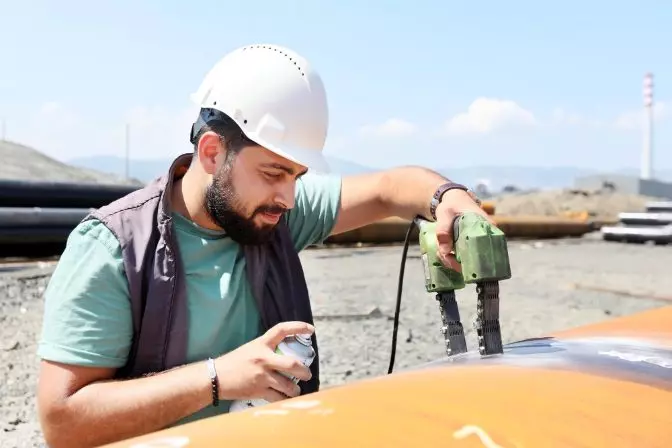
This guide provides an in-depth look at how MPI works, its advantages and limitations, common techniques, equipment used, and relevant standards. Whether you're new to the field or looking to deepen your understanding, this resource is designed to help you navigate the world of magnetic particle inspections with confidence.
The basic principle of MPI involves magnetizing the object under inspection. If there are no defects, the magnetic field flows smoothly through the material. However, when a defect is present, it disrupts the magnetic flow, creating a leakage field. Magnetic particles, either dry or in a liquid suspension, are then applied to the surface, where they gather around the leakage field, making the defect visible to the naked eye.
MPI is favored for its speed, cost-effectiveness, and ease of use. It's particularly useful for identifying small or shallow surface cracks. However, it’s important to note that this method only works on ferromagnetic materials, such as iron, steel, cobalt, and nickel.
[NDT magnetic particle testing is just one of the non-destructive testing methods that inspectors use. Learn more about NDT and the other methods used in this guide.]
What Is Magnetic Particle Testing?
Magnetic particle testing begins with the magnetization of the object being inspected. Once magnetized, if the material is free of defects, the magnetic field will pass through it without interruption. But if a flaw exists, the magnetic field will be disturbed, forming a secondary flux leakage field at the location of the defect.
Once the magnetic field is created, inspectors apply magnetic particles—either in powder form or suspended in a liquid. These particles are attracted to the leakage field, forming visible patterns that indicate the presence and location of the defect. This makes it easier for inspectors to identify and evaluate the issue.
The particles used are often black or coated with fluorescent dye, making them easier to see under certain lighting conditions. This allows for more accurate detection, especially in low-light environments.
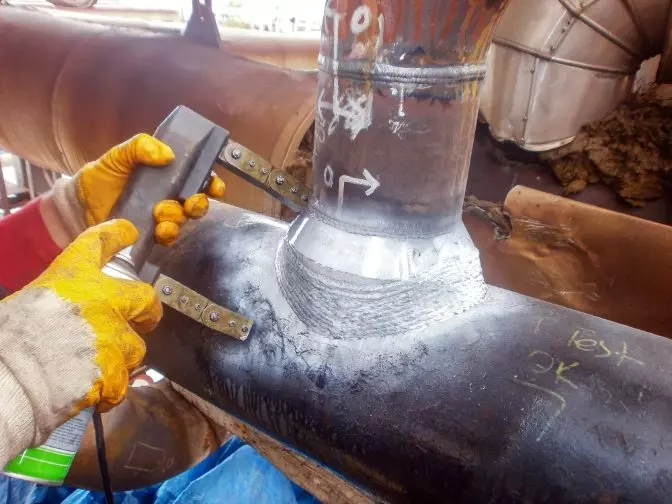
The History of Magnetic Particle Testing
The concept of using magnetism to detect material flaws dates back to 1868, when cannon barrels were tested for defects by running a magnetic compass along their length. Any disruption in the magnetic field would cause the compass needle to move, indicating the presence of a flaw.
In the 1920s, inventor William Hoke developed a method using metallic shavings to reveal defects on magnetized surfaces. This early approach laid the foundation for modern magnetic particle testing, which was later adopted by the railroad industry in the 1930s for inspecting steel components.
Today, the principles remain largely unchanged, but the tools and techniques have evolved significantly, making the process more efficient and accurate.
The Pros and Cons of Magnetic Particle Inspection
MPI offers several advantages, including portability, speed, and cost-effectiveness. It is also sensitive enough to detect fine surface cracks and can be used on irregularly shaped objects. However, it has some limitations, such as the need for ferromagnetic materials and the inability to detect deep subsurface flaws.
Here’s a detailed list of pros and cons:
Pros
- Portable and quick to perform
- Results are immediately visible
- Minimal pre-cleaning required
- Relatively inexpensive
- Sensitive to shallow cracks
- Can detect both surface and near-surface flaws
- Easy to use with minimal training
- Flexible for various shapes and surfaces
- Applicable to complex parts like crankshafts and connecting rods
Cons
- Only works on ferromagnetic materials
- Cannot detect deep subsurface defects
- Requires demagnetization after testing
- Need to align indications with the magnetic field
- Only small areas can be inspected at a time
- Paint must be removed if thicker than 0.005 inches
Magnetic Particle Testing Techniques
MPI can be conducted using either dry or wet methods. Dry Magnetic Particle Testing (DMPT) uses powdered particles, while Wet Magnetic Particle Testing (WMPT) involves suspending the particles in a liquid solution.
Inspectors can choose between fluorescent and non-fluorescent particles depending on the environment and visibility needs. Both methods are effective, but fluorescent particles offer better visibility under UV light, making them ideal for low-light conditions.
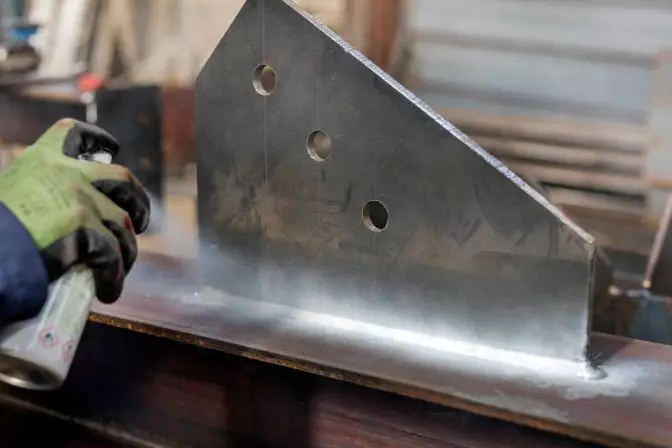
Two-Step Overview
The process typically involves two main steps:
- Magnetize the object: Apply a magnetic current to the material. Defects will create a secondary magnetic field, or flux leakage field.
- Apply magnetic particles: Spread the particles over the surface. They will be attracted to the leakage field, making the defect visible.
While the basic steps are simple, the execution requires careful attention to detail, including proper magnetization and particle application. The next section, Magnetization Considerations, covers these details in depth.
Common on-site techniques include electromagnetic yokes, current flow probes, permanent magnets, flexible coils, and adjacent cables. Each method has its own advantages and is suited for different types of inspections.
Magnetization Considerations
Magnetizing the material correctly is crucial for accurate results. There are several techniques used, each with its own benefits and applications.
Ways to Magnetize the Material
There are five primary magnetization techniques recognized by industry standards, such as ASME:
- Longitudinal magnetization
- Multidirectional magnetization
- Yoke technique
- Prod technique
- Circular magnetization
Perpendicular Application
To ensure the best results, magnetic lines of force should be applied perpendicular to the direction of the current. This helps in detecting defects that may otherwise go unnoticed.
Inspectors typically test the material twice, once in one direction and again in a perpendicular direction, to ensure full coverage. This is because a defect will only interrupt the magnetic field if it is aligned perpendicularly with the flux lines.
Direct vs. Indirect Magnetization
There are two main approaches to magnetization:
- Direct magnetization: Passing electric current directly through the material to generate a magnetic field.
- Indirect magnetization: Creating a magnetic field from an external source, such as a coil or electromagnet.
Electrical Current Considerations
The choice of electrical current depends on the inspection requirements. Alternating Current (AC) is suitable for surface defects, while Direct Current (DC) can penetrate deeper into the material, making it ideal for detecting subsurface flaws.
Other factors, such as the shape of the object, type of material, and depth of penetration, also influence the selection of the current type.
Magnetic Particle Inspection Equipment
A variety of equipment is used in magnetic particle inspections, each serving a specific purpose. From magnetic benches to power packs and yokes, these tools help create the necessary magnetic fields for accurate testing.
Some of the most commonly used equipment includes:
Magnetic Wet Benches
Magnetic wet benches allow inspectors to generate circular and longitudinal magnetic fields for testing. They are often used in controlled environments to ensure consistent results.
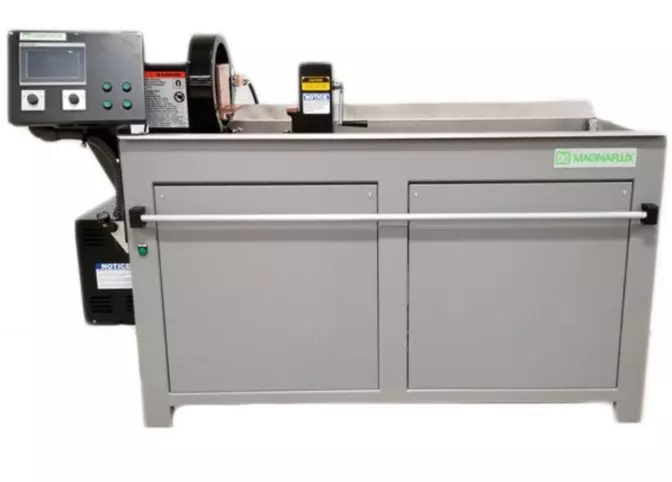
A magnetic wet bench | Credit: Magnaflux
Power Packs / Electromagnetic Current Generators
Power packs provide a quick and efficient way to generate the magnetic current needed for inspection. They are portable and easy to use, making them ideal for on-site testing.
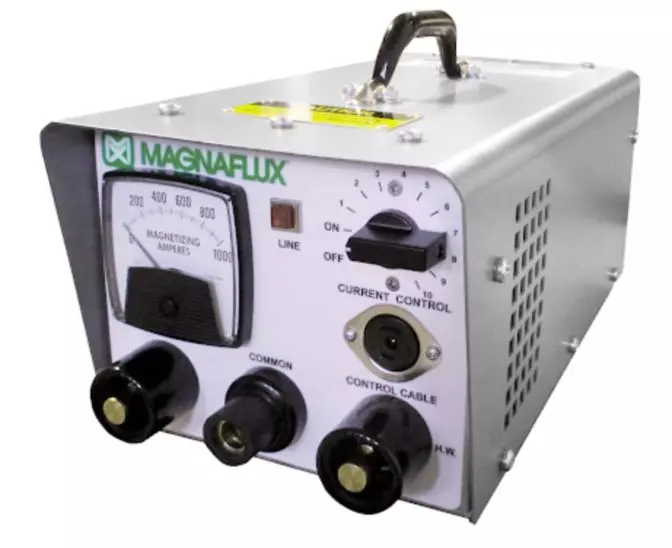 A portable power pack | Credit: Magnaflux
A portable power pack | Credit: Magnaflux
Magnetic Yokes
Magnetic yokes are used to create localized magnetic fields for inspection. They are especially useful for testing large or irregularly shaped objects.
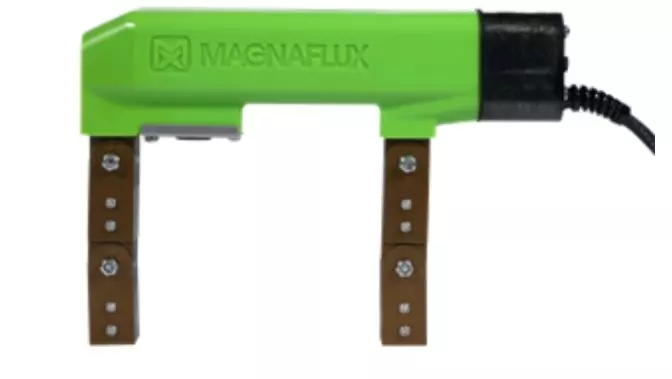 An electromagnetic AC/DC yoke | Credit: Magnaflux
An electromagnetic AC/DC yoke | Credit: Magnaflux
Enclosures, Hoods, and Curtains
These accessories are used to control the lighting conditions during testing, ensuring that the magnetic particles are clearly visible. They help maintain optimal viewing conditions for accurate results.
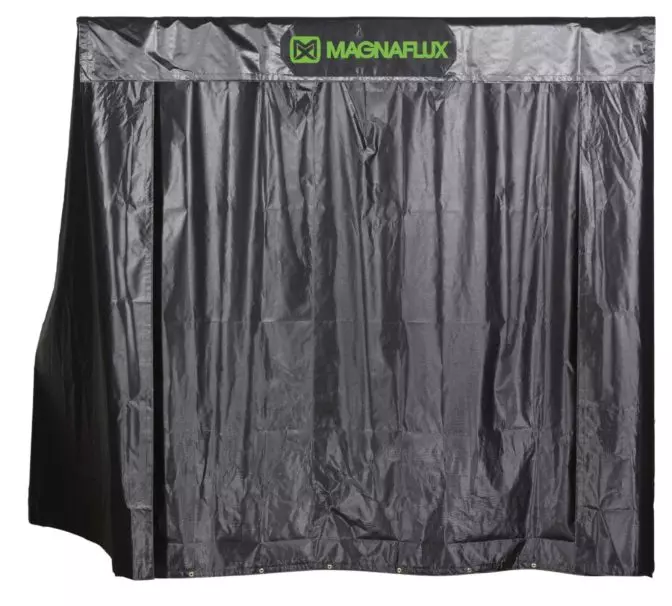 An enclosure | Credit: Magnaflux
An enclosure | Credit: Magnaflux
Demagnetizers
After testing, residual magnetism must be removed from the material. Demagnetizers are used to neutralize the magnetic field, ensuring the material is safe for further use or handling.
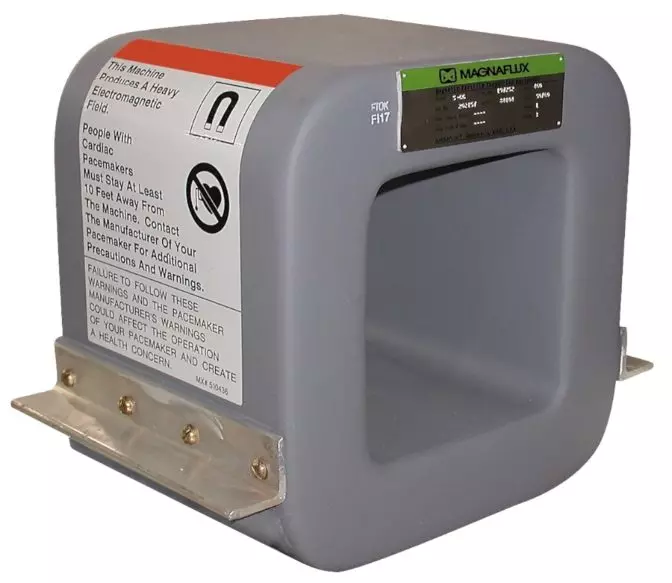
A table-top demagnetizer | Credit: Magnaflux
Magnetic Particle Inspection Standards and Codes
Many industries require adherence to specific standards when conducting magnetic particle inspections. These standards ensure consistency, accuracy, and safety across different applications.
Some internationally recognized standards include:
ASTM (American Society for Testing and Materials)
- ASTM E1444/E1444M: Standard Practice for Magnetic Particle Testing
- ASTM A275/A275M: Test Method for Magnetic Particle Examination of Steel Forgings
- ASTM A456: Specification for Magnetic Particle Inspection of Large Crankshaft Forgings
- ASTM E543: Practice Standard Specification for Evaluating Agencies that Performing Nondestructive Testing
- ASTM E709: Guide for Magnetic Particle Testing Examination
- ASTM E1316: Terminology for Nondestructive Examinations
ISO (International Organization for Standardization)
- ISO 3059: Non-destructive testing - Penetrant testing and magnetic particle testing - Viewing conditions
- ISO 9934-1: Non-destructive testing - Magnetic particle testing - Part 1: General principles
- ISO 9934-2: Non-destructive testing - Magnetic particle testing - Part 2: Detection media
- ISO 9934-3: Non-destructive testing - Magnetic particle testing - Part 3: Equipment
- ISO 10893-5: Non-destructive testing of steel tubes
- ISO 17638: Non-destructive testing of welds - Magnetic particle testing
- ISO 23278: Non-destructive testing of welds - Magnetic particle testing of welds - Acceptance levels
CEN (European Committee for Standardization)
- EN 1290: Surface Crack Testing
- EN 1330-7: Non-destructive testing - Terminology - Part 7: Terms used in magnetic particle testing
- EN 1369: Founding - Magnetic particle inspection
- EN 10228-1: Non-destructive testing of steel forgings - Part 1: Magnetic particle inspection
- EN 10246-12: Non-destructive testing of steel tubes - Part 12: Magnetic particle inspection of seamless and welded ferromagnetic steel tubes for the detection of surface imperfections
- EN 10246-18: Non-destructive testing of steel tubes - Part 18: Magnetic particle inspection of the tube ends of seamless and welded ferromagnetic steel tubes for the detection of laminar imperfections
Gas Cylinder Storage Cage,Gas Cylinder Storage Rack,Kinds Of Gas Cylinder Rack,Customized Stackable Gas Bottle Rack
Hangzhou Qizheng Trading Co., Ltd. , https://www.gascylindercap.com